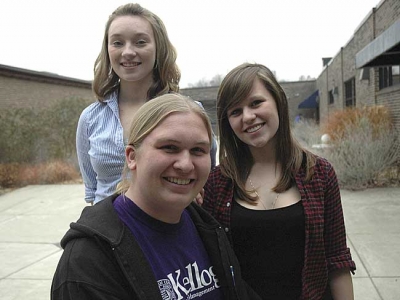Gardens, gardeners sprouting
- Published: April 7, 2011
What began as a modest effort to start a community garden has mushroomed to four neighborhood gardens scattered around town — with more soon to sprout.
When two seasons ago a small group of local gardeners who set out to raise food together at Bill Duncan Park were thwarted by opposition, they made an ambitious move — propose eight gardens instead of one — and have not turned back. Last year more than 50 families grew food together at four plots around town, including at Bill Duncan Park, where 20 people raised food.
This season the number of gardens in production may grow to 12, serving 300 village residents by 2015, according to organizer Doug Bailey, known locally as Thor. Sign-ups for space at Bill Duncan, the Glass Farm, Fair Acres and Friends Care have begun, and more garden sites — on both Village-owned and private land — could open up before spring planting.
“Space is not a limitation — there is so much vacant land around town,” Bailey said. “And we can get a lot done on a very small acreage.”
The gardens have room to grow. With 0.3 acres now in production, just two percent of Village-owned land is dedicated to the effort, Bailey said. This year the group is eyeing expansion onto Village land at Corry and President Streets and near the Union Schoolhouse, while privately-owned plots may host gardeners in coming years.
For Kate Anderson, the garden at Fair Acres offers sunny space to grow food and flowers and a chance to connect with her neighbors.
“Everyone was so happy to have a place to plant,” said Anderson, whose shady backyard had limited her gardening efforts. “It’s very communal — we talk about what we plant and how we deal with issues.”
Last year the group of eight families at Fair Acres eschewed chemicals on their plots (only organic methods are allowed) and worked together to battle ground critters and procure water. But each household grew what it wanted on plots of about 10-by-15 feet, with Anderson choosing cherry tomatoes and zinnias among her produce.
About half of the neighborhood gardeners lack sufficient sunlight in their yards to grow enough food, while others are apartment dwellers without access to soil or those who just want to garden with their friends and neighbors, Bailey said.
“We have so many trees in town,” he said. “Now we can have our cake and eat it too — we can have our trees and have our gardens.”
The neighborhood gardens owe their legacy to two previous efforts — the Friends Care Intergenerational Garden and a community garden on the Village-owned Sutton Farm. According to Al Schlueter, who helped seed the Sutton farm project in the mid-1970s, the garden flourished but eventually lost energy, in part because it was far from people’s homes.
“This is a renewal effort, but by being within the neighborhoods it’s more visible and connected,” said Schlueter, who last week spaded up new beds at Fair Acres, where he has a plot. “I’m convinced this is a better project because it’s in the neighborhoods.”
To mentor new gardeners, each site has an expert on hand to give advice and assistance. Most people have asked for more space this year and few have dropped out, proof that the mentorship model is working, Bailey said.
After the first year of planting, opposition to the gardens has been low, owing to the well-tended rows, innovative approaches to site problems, careful site selection and continuing dialogue between landowners and neighbors, Bailey said.
Gardens in place at Fair Acres and the Glass Farm, also known as Frogtown Reserve, have been moved to accommodate children’s play areas and to move farther away from commercial farming, respectively, while spaces at Ellis Pond and the Bryan Center were not considered at all or were eliminated because of competing community uses. Though many were initially skeptical about water availability, Delaine Adkins innovated a low-tech water procurement system at Bill Duncan Park using a covered children’s pool to collect rainwater and capture condensation.
Under negotiation with the Village is a 0.6 acre parcel on Corry Street at President Street, the site of a former sewage treatment plant built by Hugh Taylor Birch in the 1920s. Soil testing is underway to ensure the plot is a safe place to grow food.
The good relationship with the Village, which was formalized in a 2009 Council resolution supporting the neighborhood garden project, has helped the gardens flourish, Bailey said. Bailey’s idea for the project germinated at the Environmental Commission, which gives no funds to the effort.
“The gardens are autonomous,” Bailey said. “The gardeners are the ones who make this happen.”
Though those wishing to raise food on Village-owned land must live or work in town, the gardening group is non-exclusive and anyone can get a plot at one of the private sites. An ancillary organization, the Yellow Springs Community Gardeners, is open to any green thumb, neighborhood gardener or not. That group hosts monthly potlucks among local gardeners and last month put on its annual seed exchange.
Interested gardeners can sign up at the Village offices, the library, Tom’s Market or Eco•Mental, or contact Thor at 767-2729.
The Yellow Springs News encourages respectful discussion of this article.
You must login to post a comment.
Don't have a login? Register for a free YSNews.com account.
Parkinsons.jpg)














No comments yet for this article.